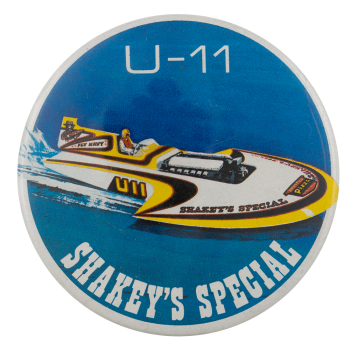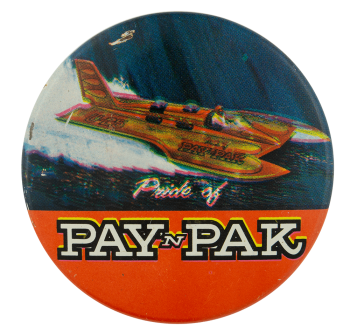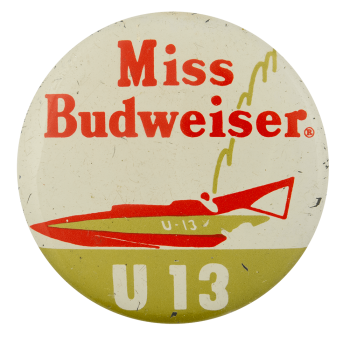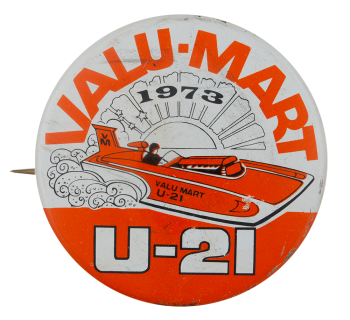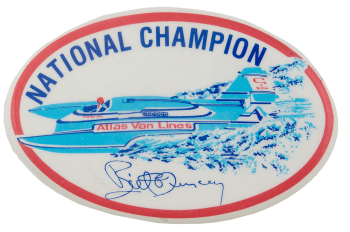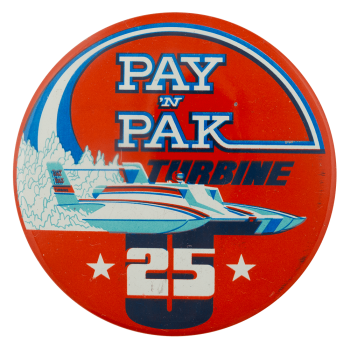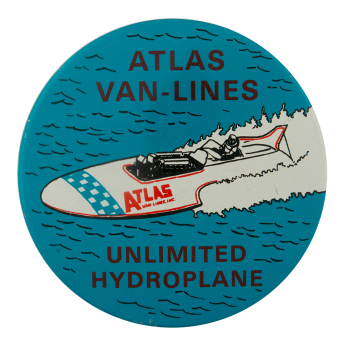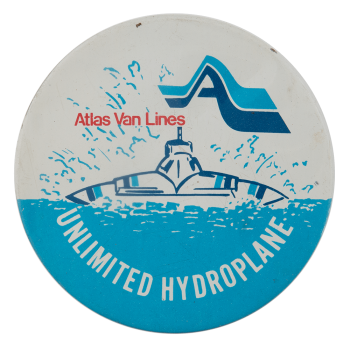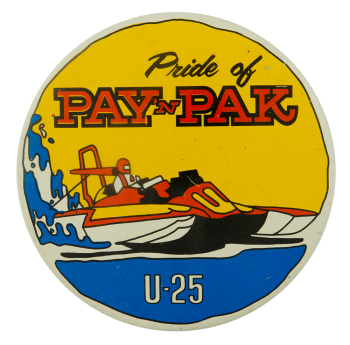| Information |
CBS-TV promotional button for the upcoming series Evil. Handed out at New York Comic Con October 2019. The button was attached to a card announcing a screening and panel discussion at 5:15 PM No curl text Locking pin 2 1/4 inch round |
|---|---|
| Button Image | |
| Additional Image |
U11 Shakeys Special
| Category | |
|---|---|
| Additional Images | |
| Sub Categories | |
| Text on Button | U-11 SHAKEY'S SPECIAL; Fly Navy; Shakey's Pizza |
| Image Description | Image of boat in yellow, white, and black in center. White text on blue background. |
| Back Paper / Back Info |
INSTA-BUTTON FROM THE RICHMARK CO., 1110 E. Pine St. Seattle Wash. 98122 |
| Back Style | |
| The Shape | |
| The Size | |
| Year / Decade Made | |
| Additional Information | The Shakey's Special was an unlimited hydroplane first raced in 1973. Tom Martin, Seattle restaurant owner and owner of the first Shakey's Pizza, was a sponsor and a driver of unlimited hydroplane speedboats. Martins's debut race in 1973 was in Shakey's Special; he was unable to finish the race, however, due to mechanical problems. |
| Sources |
Farley, F. (2002). Tom martin remembered. Retrieved from http://thunderboats.ning.com/page/tom-martin-remembered |
| Catalog ID | SP0176 |
Pride Of Pay N Pack Color
| Category | |
|---|---|
| Additional Images | |
| Sub Categories | |
| Text on Button | U-25 PAY 'N PAK Pride of PAY 'N PAK |
| Image Description | Image of boat on water with white and black text above white text with black and yellow outline on orange background. |
| Back Style | |
| The Shape | |
| The Size | |
| Additional Information | The Pride of Pay ‘n Pak was a line of hydroplanes that competed in unlimited hydroplane racing. The Pride of Pay ‘n Pak emerged from the efforts of David Heerensperger. After Heerensperger started a new electrical and plumbing company in 1959, with backing from Stan Thurman, owner of the Pay ‘N Pak home improvement chain, he became sponsor of the Miss Spokane Hydroplane Racing Team in 1963 after responding to an ad. The boat’s name was changed to the Miss Eagle Electric and went on to finish third in 1963 Harrah’s Tahoe Regatta and fourth in 1964 Seattle Seafair Regatta. In 1969, the Pay ‘N Pak Stores, along with T & T Electric, and Heerensperger’s companies Eagle Electric and Buzzard Electric all merged into a new Pay N Pak Corporation. After the merger, Heerensperger managed the Pay ‘n Pak operations in Spokane, WA and the sponsorship of the hydroplane racing team. The Pride of Pay ‘n Pak was the first boat from the racing the team that featured an outrigger design. The Pride of Pay ‘n Pak was redesigned in the 1970s with dual Hemi automobile engines instead of conventional piston aircraft engines. The team won the points championship from 1973-1975 and sponsored the first winning turbine powered hydroplane from 1980 to 1983. The 1980 design of the U-25 Pay ‘N Pak crashed during the 3rd race of the season and was the last boat to carry the name Pride of Pay ‘n Pak. |
| Sources |
Farley, F. (2015, May 14). The Dave Heerensperger/Pay ‘n Pak saga. H1 Unlimited. Retrieved from https://www.h1unlimited.com/2015/05/the-pay-n-pak-saga/ History of Pay ‘n Pak racing. (n.d.). Hydroplane and Raceboat Museum. Retrieved from http://thunderboats.ning.com/page/history-of-pay-n-pak-racing Pay ‘n Pak in Kent. (n.d.). Greater Kent Historical Society. Retrieved from http://kenthistoricalmuseum.org/?page_id=2806 |
| Catalog ID | SP0175 |
Miss Budweiser U13
| Category | |
|---|---|
| Additional Images | |
| Sub Categories | |
| Text on Button | Miss Budweiser® U-13 U-13 |
| Image Description | Image of red and gold speedboat with red upper text on white background and white lower text on gold background. |
| Curl Text | Union bug |
| Back Style | |
| The Shape | |
| The Size | |
| Additional Information | The Miss Budweiser, the name of a racing boat, has encompassed more than twenty boats over it’s run in the American Power Boat Association over the course of four decades. The owners, Bernie and Joe Little, cultivated a friendship with August Busch III who used Budweiser to sponsor the team. The first Miss Budweiser hull debuted in 1956 and utilized the U-12 hull as a build. This hull was replaced by the U-13 in 1963. The team finally won their first race in 1966, winning the Atomic Cup in Tri-Cities, Washington. The team then won the ultimate prize of the league, the Gold Cup, in 1973. The Miss Budweiser would continue racing and appearing in other festivals and events until 2004. This is when the sponsorship was pulled, and Miss Budweiser went into retirement. |
| Sources |
Farley, F. (n.d.). Famous Miss Budweisers of the past. Hydroplane and Raceboat Museum. https://thunderboats.ning.com/page/famous-miss-budweisers-of-the-past Stewart, R. (2004, March 3). Miss Budweiser Announces Last Call. https://www.14news.com. https://www.14news.com/story/1679967/miss-budweiser-announces-last-call/
|
| Catalog ID | SP0174 |
Valumart U21
| Category | |
|---|---|
| Additional Images | |
| Sub Categories | |
| Text on Button | VALU-MART 1973 VM VALU MART U-21 U-21 |
| Image Description | Orange, black, and white text with black and orange illustrations over white upper background and orange lower background. |
| Back Style | |
| The Shape | |
| The Size | |
| Year / Decade Made | |
| Additional Information | Driven by Bill Wurster, who first began driving hydroplane speed boats in 1972, the VALU-MART failed to qualify in the 1973 Gold Cup race in Tri-Cities, Washington. The 1973 Gold Cup race consisted of 15 boats. Two boats didn’t qualify during the race, the VALU-MART II and Redman Too. Hydroplane speed boat racing began in the 1920's, but gained popularity for a second wave when boats were upgraded with airplane machinery and parts after WWII. This trend continued after the Vietnam War and records continued to get broken by new advances in technology. |
| Sources |
Williams, D. (2008). Hydroplane racing in the tri-cities. https://books.google.com/books?id=sqRIUVY1PrYC&pg=PA29&lpg=PA29&dq=valumart+1973&source=bl&ots=YIkao5evwY&sig=ACfU3U2-y511uCJ8Al4S041Owf11yFpSXw&hl=en&ppis=_c&sa=X&ved=2ahUKEwig0tbV5YnoAhXihHIEHYNUAxkQ6AEwA3oECAoQAQ#v=onepage&q=valumart%201973&f=false |
| Catalog ID | SP0173 |
National Champion Boat
| Category | |
|---|---|
| Additional Images | |
| Sub Categories | |
| Text on Button | NATIONAL CHAMPION Atlas Van Lines U-1 Atlas Van Lines Bill Muncey |
| Image Description | Illustration of blue and white speedboat with red text. Surrounding boat, text is blue on white background with red outline. |
| Back Style | |
| The Shape | |
| The Size | |
| Additional Information | Bill Muncey, a well regarded racer in the history of hydroplane racing overturned his Atlas Van Lines boat at the World Championship race in Acapulco, Mexico, and died on October 18, 1981. Bill drove the Atlas Van Lines boat known as the Blue Blaster from 1977 to 1981 winning 24 races and two championships in the Blue Blaster. Atlas Van Lines sponsored the boat in the 1970's and 1980's. After Bill's death, the Blue Blaster was preserved but was no longer sea worthy. In 2010, the Hydroplane and Race Boat Museum acquired the Blue Blaster and spent the next four years restoring it with the intention of returning it to the water and honoring Bill Muncey's memory. In the summer of 2014, the Blue Blaster returned to the water after it was newly christened by Muncey's wife, Fran, during Seattle's Seafair. |
| Sources |
Amplifier. (2014 November 26). A blast from the past. Retrieved from https://www.atlasvanlines.com/amplifier/atlas-companies/atlas-van-lines/a-blast-from-the-past |
| Catalog ID | SP0172 |
Pay N Pack 25
| Category | |
|---|---|
| Additional Images | |
| Sub Categories | |
| Text on Button | PAY 'N PAK TURBINE U 25 |
| Image Description | White and blue text with illustration of speedboat making blue and white lines on red background. |
| Back Style | |
| The Shape | |
| The Size | |
| Additional Information | The Pay-n-Pak U-25 Turbine was a revolutionary boat in the world of hydroplane boat racing. Owned by Dave Heerensperger, this boat was the first to use a single turbine power plant on its U-25 hull design in the Unlimited class of racing. The new boat debuted in 1980 but in its first race flipped during trials and was unable to compete. After a series of high places, it finally won its first race in 1982 making it the first non-internal combustion engine to win an Unlimited race. Shortly after this historic win, the boat was involved in a crash with several others and it’s driver John Walters was severely injured. Shortly after, Heerensperger sold his team and retired from the sport. The Pay-n-Pak U-25 remains one of the defining boats in Unlimited Hydroplane Racing history. Eventually, all of the other boats would mimic the U-25 and feature a turbine engine. |
| Sources |
Farley, F. (n.d.). The Dave Heerensperger / Pay ‘n Pak saga. In H1 Unlimited. Retrieved from https://www.h1unlimited.com/2015/05/the-pay-n-pak-saga/ |
| Catalog ID | SP0114 |
Atlas Van Lines Hydroplane
| Category | |
|---|---|
| Additional Images | |
| Sub Categories | |
| Text on Button | ATLAS VAN-LINES ATLAS VAN-LINES, INC. UNLIMITED HYDROPLANE |
| Image Description | Illustration of speedboat with red text surrounded by black text and illustration on blue background. |
| Back Style | |
| The Shape | |
| The Size | |
| Additional Information | William Edward "Bill" Muncey (November 12, 1928 – October 18, 1981) was an American hydroplane racing legend from Detroit, Michigan. The International Motorsports Hall of Fame and hydroplane historian Dan Cowie described Muncey as "without question, the greatest hydroplane racer in history." Muncey was nicknamed "Mr. Unlimited" and won 62 races, which was the most races in the history of the sport until Dave Villwock broke his record in 2011. Muncey began his boat racing career in 1949 by sinking in front of a hometown crowd on the Detroit River. He moved to a new Atlas Van Lines boat in 1977 and won twenty times in the next three seasons. Muncey was leading the final heat of the World Championship race at Acapulco on October 18, 1981, when he died in a blowover crash while travelling 175 miles per hour (282 km/h). Atlas Van Lines is an American moving company formed in 1948 by a group of local transfer and storage firms. As an agent-owned company, it is similar in form to a cooperative. It has about 500 agents worldwide (in over 140 countries), of which 75 own shares in Atlas World Group, which controls Atlas Van Lines and other related companies. Based in Evansville, Indiana, it is the second-largest interstate motor carrier in the United States. |
| Sources |
"About Atlas". Atlas World Group. Archived from the original on 5 December 2008. Retrieved 2008-12-04. https://web.archive.org/web/20081205004016/http://www.atlasworldgroup.c… Biography Archived July 3, 2007, at the Wayback Machine at the International Motorsports Hall of Fame, Retrieved May 23, 2007 https://web.archive.org/web/20070703222305/http://www.motorsportshallof… "Death ends career of a racing legend". Spokesman-Review. (Spokane, Washington). Associated Press. October 20, 1981. Bill Muncey at the Motorsports Hall of Fame of America. (2019, October 17). Retrieved November 10, 2019, from https://www.mshf.com/hall-of-fame/inductees/bill-muncey.html |
| Catalog ID | SP0112 |
Unlimited Hydroplane
| Category | |
|---|---|
| Additional Images | |
| Sub Categories | |
| Text on Button | Atlas Van Lines UNLIMITED HYDROPLANE |
| Image Description | Image of speedboat in shades of blue and white with A logo in upper right. Upper left is red text on white. Lower half is white text on light blue. Majority of background is white. |
| Back Style | |
| The Shape | |
| The Size | |
| Additional Information | The Atlas Van Lines is one of the most successful, yet tragic, hydroplanes to ever compete in racing. For most of its tenure, it was piloted by veteran Bill Muncey, who many doubted if he would ever win again due to his age. From 1976 to 1981, Bill and Atlas dominated the sport, winning five races in their first year together. From 1977 to 1981, the pair competed in 43 races and won 24 of them. Unfortunately, in its last race in 1981, Bill and Atlas suffered a tragic accident. Traveling at over 175 miles per hour, the hydroplane flipped, and Bill later died at the hospital from his injuries. The hydroplane was restored in 2014 to honor Bill’s memory. |
| Sources |
Atlas Van Lines. (2014, November 26). A blast from the past. https://www.atlasvanlines.com/amplifier/atlas-companies/atlas-van-lines… |
| Catalog ID | SP0098 |
Pride Of Pay N Pack
| Category | |
|---|---|
| Additional Images | |
| Sub Categories | |
| Text on Button | Pride of PAY 'N PAK U-25 |
| Image Description | Black, red, and white text with illustration of speedboat on yellow above and blue and white below; all on white background. |
| Back Style | |
| The Shape | |
| The Size | |
| Additional Information | Pay n’ Pak was a home improvement chain that was founded by Steve Thurman in 1962 and later taken over by David Heerensperger in 1969. Heerensperger oversaw the expansion of the company. In 1989, there was an attempt of a hostile take over of the company so Heerensperger left and made a competitor chain, Eagle Hardware, in response. The hydroplane project was an investment Heerensperger made when he took over up until he left the company, specifically hydroplane racing. It was considered a dangerous sport in the 1960s and 1970s at the time when he was racing. His team won 25 races while he was in control. |
| Sources |
Fields, A. (2018, December 7). David Heerensperger, hydroplane owner, tough businessman, and ‘the kindest man you could ever hope to meet’. Seattle Times. Retrieved July 15, 2020, from https://www.seattletimes.com/seattle-news/david-heerensperger-hydroplan… |
| Catalog ID | SP0083 |

